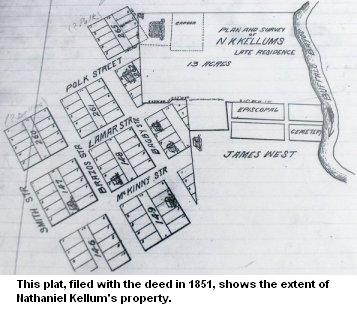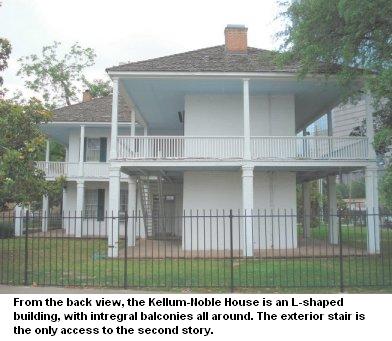 The view
for boaters on the bayou as they approach Interstate 45 is that of a
maze of bridges. There are separate bridges for the north bound and
south bound lanes of the freeways. Sliding off of these main lanes is
an intricate array of entrance and exit ramps, each forming its own
bridge over the bayou. All in all there are eight distinct bridge
structures associated with the I-45 freeway at this point. In order,
going downstream, they are: 1) the West Dallas Avenue exit ramp, 2) the
I-45 south main lanes, 3) the Allen Parkway exit ramp, 4) the I-45
North main lanes, 5) the Memorial Drive exit ramp, 6) the I-45 North
entrance ramp from Allen Parkway, 7) the McKinney Avenue exit ramp, and
8) the Walker Avenue entrance ramp.
The view
for boaters on the bayou as they approach Interstate 45 is that of a
maze of bridges. There are separate bridges for the north bound and
south bound lanes of the freeways. Sliding off of these main lanes is
an intricate array of entrance and exit ramps, each forming its own
bridge over the bayou. All in all there are eight distinct bridge
structures associated with the I-45 freeway at this point. In order,
going downstream, they are: 1) the West Dallas Avenue exit ramp, 2) the
I-45 south main lanes, 3) the Allen Parkway exit ramp, 4) the I-45
North main lanes, 5) the Memorial Drive exit ramp, 6) the I-45 North
entrance ramp from Allen Parkway, 7) the McKinney Avenue exit ramp, and
8) the Walker Avenue entrance ramp.Each of these bridges is supported by large concrete pillars, many of which are located within the stream bed of Buffalo Bayou. At normal water levels, these mid-channel obstacles do not present any major difficulty to boaters. However, when the rate of flow increases to levels above 1,000 cfs or more, the pillars become dangerous obstacles for canoers, kayakers and other boaters to negotiate. Caution should be carefully observed when weaving through the strong currents and billows that form around the bridge supports.
The nest of concrete associated with I-45 also obscures the view of the historic Sam Houston Park which lies on the south bank of the bayou where the bayou begins its gentle turn to the northeast. With a glance over the right bank immediately before the McKinney Avenue ramp, the tops of a number of the houses and buildings of the park can be seen from the bayou.
Sam Houston Park has the distinction of being the first public park land acquired by the City of Houston. In June, 1899, Mayor Samuel Brashear purchased land for a city park that included the old Samuel Young brickyard on the north side of Buffalo Bayou and the Noble and Byers property on the south side. Although the tracts had played a significant role in Houston for over fifty years, the properties had fallen into disrepair by the time of the purchase. The Noble family home, which had been built by Nathaniel Kelly Kellum in 1847, was the main structure on the property, and it was salvaged for use as the headquarters for the park.
As early as 1837, the banks along this area of Buffalo Bayou were identified as a source of clay for making bricks. It was about this time that a man named Hathaway had a brick yard near the foot of McKinney Avenue. The demand for building materials in the early days of Houston inspired others to try to exploit the natural resources in the area, and by 1842, Nathaniel Kellum was advertising high quality bricks for sale from his brick yard near the foot of Lamar Avenue.
Kellum, who was born in Virginia about 1818, arrived in Houston in early 1839. He began to purchase lots in town in May, 1839, but eventually, the twenty-one year old Kellum set up a kiln and brick yard operation on the southwest edge of town. Nathaniel Kellum married Elmyra Cotton on January 23, 1842, and he set out to establish himself in the community. In July, 1842, the local newspaper reported that Kellum's bricks were of a quality similar to those bricks which were imported from the United States. With the success of his brick business, Kellum then sought to acquire ownership of the land for his enterprise.
 In a series of
transactions in 1844 and 1845, Kellum put
together the tract of about thirteen acres where he had established his
operations and, later, built his home. Kellum purchased 2.1 acres for
$200 from James J. Holman on February 9, 1844, adjoining the property
that he was already using as his brick yard. On May 16, 1844, he
purchased eight acres where he had his brickyard for $500 from Thomas
M. Bagby. This tract had previously belonged to William N. Mock and was
resided on by R. P. Stewart, but Augustus C. Allen had forced the
property into foreclosure in 1839, and it was sold to Bagby in a
sheriff's sale in 1843. Lastly, on November 22, 1845, Nathaniel Kellum
bought eight town lots adjoining his property on the east from Francis
R. Lubbock for $150. These lots comprised a tract known as the Hospital
Lot where Ashbel Smith had established the General Military Hospital
for the Republic of Texas in 1837. The hospital ceased to exist in 1841
after the capital was moved to Austin and the army was disbanded.
In a series of
transactions in 1844 and 1845, Kellum put
together the tract of about thirteen acres where he had established his
operations and, later, built his home. Kellum purchased 2.1 acres for
$200 from James J. Holman on February 9, 1844, adjoining the property
that he was already using as his brick yard. On May 16, 1844, he
purchased eight acres where he had his brickyard for $500 from Thomas
M. Bagby. This tract had previously belonged to William N. Mock and was
resided on by R. P. Stewart, but Augustus C. Allen had forced the
property into foreclosure in 1839, and it was sold to Bagby in a
sheriff's sale in 1843. Lastly, on November 22, 1845, Nathaniel Kellum
bought eight town lots adjoining his property on the east from Francis
R. Lubbock for $150. These lots comprised a tract known as the Hospital
Lot where Ashbel Smith had established the General Military Hospital
for the Republic of Texas in 1837. The hospital ceased to exist in 1841
after the capital was moved to Austin and the army was disbanded.In 1847, Nathaniel Kellum began construction of a stately white brick house in the style of a Louisiana plantation from bricks fired in the kiln at his brickyard. The two story, Southern colonial brick structure displays an Old Louisiana French influence in its double verandas that are supported by narrow, square brick pillars.
Nevertheless, despite these accomplishments, Kellum began to liquidate his land holdings in Houston in 1849. On October 13, 1849, Kellum granted his power of attorney to Benjamin A. Shepherd to sell his former residence and brickyard, comprising about fourteen acres, a two story building, out houses and other improvements. On January 29, 1851, Shepherd sold the Nathaniel Kellum brickyard property to Abram W. Noble for $2000 with a promissory note due on April 1, 1852.
Kellum may have been motivated to find a better place to raise his growing family, especially following the births of his sons Robert in 1844, Nathaniel in 1846 and Ruthven in 1849. By November, 1850, the Kellum family had settled in Grimes County about ten miles northwest of the town of Anderson. The land that Kellum acquired included a sulphur spring that had been identified as early as 1836 as the Navasota Sulpur Springs. Jacob DeCordova's map of 1849 identified the spring site as White Sulphur Springs, but the J. H. Young map of Texas in 1850 referred to the place as Kellum's Sulphur Springs.
By the mid-1850's, Kellum had built a resort and health spa around his mineral springs. The complex included a two story, fifty room hotel, eighteen cottages, a bathhouse and several reservoirs. Spring water was pumped into the hotel. Accommodations could be had for 400 to 500 persons with board, lodging and bathing priced at $1 per day. The hotel was the social center of the resort with musicians on the staff and, every Tuesday evening, parties and dances were held in the second floor parlor.
During the mid-nineteenth century, Texans sought recreation and the healing influences on mineral waters at springs in the countryside. Thousands of visitors enjoyed the small resorts and health spas like Kellum Springs and Piedmont Springs, located about ten miles to the southwest of Kellum Springs. Like Kellum Springs, Piedmont Springs developed extensive facilities. A four story hotel with a hundred rooms was built there about 1860, and the resort became even more popular than Kellum's, with entertainment that included billiards, poker and horse racing.
A small community grew up around Kellum's resort, and, on October 11, 1859, Kellum was appointed the postmaster of Kellum's Springs, Texas. The success of Kellum's venture in his resort was evident by 1860 when he declared that he owned real estate valued at $20,000 and held personal assets of $25,000. Nevertheless, the difficulties of the Civil War led to a decline in business at the resort. In newspaper ads in August, 1862, Kellum assured the public that Kellum Springs was indeed open for business. In deference to the hardships of the war, however, Kellum wrote that dance parties at Kellum Springs were suspended for the duration of the conflict.
The economic downturn in the aftermath of the Civil War led to a significant decline in business at resorts like Piedmont Springs and Kellum Springs. Nathaniel Kellum died prior to 1870 and the valuation of the property dropped to about $3,000. Nevertheless, on August 29, 1877, the Navasota Tablet reported that groups of ladies and gentlemen from Navasota, Anderson and the surrounding countryside made weekly visits to both Kellum Springs and Piedmont Springs and they enjoyed the resorts. On July 29, 1879, Grimes County Sentinel reported that Grimes County had some of finest springs and summer resorts in Texas, including Kellum Springs and "the celebrated Piedmont springs." Eventually, though, after the death of Kellum's wife, the upkeep of Kellum's hotel deteriorated to a large extent and the building was condemned.
Yet, the Kellum Springs area served as a community gathering place well into the 1890's. On July 13, 1894, Dr. J. J. Burroughs, the populist candidate for Congress, and Congressman Tom Ball met in a debate at Kellum Springs. Two years later, in the next election campaign, the Honorable Tom Ball, the Democratic candidate for the First Congressional District, and Joe Eagle, the populist, held a debate at Kellum's Springs on August 27, 1896. The newspaper reported that both the debate and the associated barbecue were a success. Nevertheless, Kellum Springs, as well as the other mineral water spas and resorts in Texas, closed and were largely forgotten in the twentieth century.
 After
Kellum's departure from Houston, the
Kellum house and brick yard property became the home of the family of
Abram Noble. Abram Washington Noble, born in Lawrence County,
Mississippi on February 28, 1815, brought his wife Louisa and their
young daughter to Nacogdoches County, Texas in 1840, following his
older brothers Edward who came to Texas in 1837 and Stephen who came in
1838. Louisa Noble died in 1849 and Abram Noble settled his family,
which by then included five children, in Houston in 1849, but it is
unclear whether the move to Houston occurred before or after the death
of his wife. In April, 1849, Abram Noble married Zerviah Metcalf
Robinson Kelly, a widow from Connecticut with a daughter, Catherine,
who was born in 1834. In early 1851, the large extended family moved
into the Kellum house. Shortly thereafter, on February 10, 1851,
Zerviah Noble opened a school in her home for children under twelve
years old. She was assisted by her seventeen year old daughter Miss C.
A. Kelly, and several of her stepchildren were students.
After
Kellum's departure from Houston, the
Kellum house and brick yard property became the home of the family of
Abram Noble. Abram Washington Noble, born in Lawrence County,
Mississippi on February 28, 1815, brought his wife Louisa and their
young daughter to Nacogdoches County, Texas in 1840, following his
older brothers Edward who came to Texas in 1837 and Stephen who came in
1838. Louisa Noble died in 1849 and Abram Noble settled his family,
which by then included five children, in Houston in 1849, but it is
unclear whether the move to Houston occurred before or after the death
of his wife. In April, 1849, Abram Noble married Zerviah Metcalf
Robinson Kelly, a widow from Connecticut with a daughter, Catherine,
who was born in 1834. In early 1851, the large extended family moved
into the Kellum house. Shortly thereafter, on February 10, 1851,
Zerviah Noble opened a school in her home for children under twelve
years old. She was assisted by her seventeen year old daughter Miss C.
A. Kelly, and several of her stepchildren were students.Zerviah Noble lived and taught school in the Kellum-Noble House until the 1890's. She operated it as a private school at first, then as one of Houston's first public schools. When the City's public school system was established in 1877, her school became the Fourth Ward Public School.
 Abram
Noble took over Kellum's brick yard
business about 1851. By 1860, he employed one brick maker and four
laborers at his brick yard, and he was moderately successful in the
venture. During the Civil War, Noble served as a captain in the
Confederate army. Zerviah and Abram W. Noble divorced in 1865, and
Abram moved to Kaufman County in that same year. Zerviah Noble retained
the Kellum-Noble house and continued her career as a teacher and
principal there almost until her death in 1894.
Abram
Noble took over Kellum's brick yard
business about 1851. By 1860, he employed one brick maker and four
laborers at his brick yard, and he was moderately successful in the
venture. During the Civil War, Noble served as a captain in the
Confederate army. Zerviah and Abram W. Noble divorced in 1865, and
Abram moved to Kaufman County in that same year. Zerviah Noble retained
the Kellum-Noble house and continued her career as a teacher and
principal there almost until her death in 1894.In June, 1899, Mayor Samuel Brashears purchased the land, which included the Noble property, that became the city's first public park. In 1902, Mayor O. T. Holt formed the Parks Department to maintain the City Park. When it opened, the City Park was decorated with flowers and plants, and it was made appealingly bucolic with wooden footbridges, an old mill and a picturesque pond. A small zoo featured native Texas wildlife including squirrels, rabbits, prairie dogs and alligators. By 1913, the park had been named in honor of Sam Houston.
As other parks were developed in the city, the use of Sam Houston Park declined. The zoo was relocated to a new thirty-four acre site in Hermann Park on January 11, 1925. By the early 1950's, Sam Houston Park and its main facility, the Kellum-Noble house, were in danger of being demolished. Fortunately, a group of concerned citizens recognized the value of the historic brick home and its park land. The Harris County Heritage Society was formed in 1954 to save the house and the park, and the downtown city park has become the focal point for the preservation of historic Houston structures. The Kellum-Noble House is the oldest surviving brick structure in Houston, and it sits on its original location.